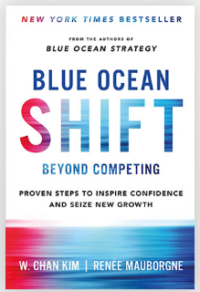 Blue Ocean Strategy is a transformational concept that was introduced by W. Chan Kim and Renee Mauborgne through a 2004 article in Harvard Business Review; in two books titled Blue Ocean Strategy and Blue Ocean Shift; and through the Blue Ocean Strategy website.
Blue Ocean Strategy is a transformational concept that was introduced by W. Chan Kim and Renee Mauborgne through a 2004 article in Harvard Business Review; in two books titled Blue Ocean Strategy and Blue Ocean Shift; and through the Blue Ocean Strategy website.
Elements of Blue Ocean Strategy have been adopted by a wide range of firms all over the world, primarily in business but also in the social sector including nonprofits and government agencies. In today’s environment, Blue Ocean Strategy can be especially helpful for social sector leaders faced with mapping new directions through a shifting landscape.
What is Blue Ocean Strategy?
The authors introduce the concept of Blue Ocean Strategy in contrast to its counterpart, Red Ocean Strategy.
- Red Ocean Strategy. Think of a Red Ocean as an existing market space defined by intensive competition for customers and revenue. In Red Ocean Strategy, a firm intensively competes with the goal of beating the competition by serving existing demand with better services, lower costs, or both. In the process they may face serious challenges as they fight for pieces of highly contested market share.
- Blue Ocean Strategy. Think of a Blue Ocean as a new market space with potential customers and little or no existing competition. In Blue Ocean Strategy, a firm creates uncontested market space with the goal of making the competition irrelevant by creating and capturing new or untapped demand. This eases the pressure to fight for market share, and generates new possibilities for delivering high value at an efficient cost. In addition to a new service model, a new revenue model may be needed to support Blue Ocean strategy.
As a result of the difference in market dynamics between Red Ocean and Blue Ocean strategy, the two approaches have differing requirements for leadership, management, and organization development. The Blue Ocean Strategy books and website articulate these differences, and provide practical tools and insights for pursuing Blue Ocean Strategy.
How might we apply Blue Ocean Strategy in the Social Sector?
Many social sector organizations are operating in a shifting environment marked by changes in community demographics, funder interests, public policy, and expectations for delivering value. In this situation, it is essential to be creative about envisioning a future for the organization. Blue Ocean Strategy can help us analyze the possibilities and develop a strategic vision. We can start by asking these questions.
- What kind of market space are we in? Are we in a Red Ocean with intense competition? Are we already in a Blue Ocean with demonstrable need and little or no competition for clients and funding? Or is our ocean shifting from Blue to Red due to emerging competitors, changes in funder interests, or changes in public policy?
- What does our future look like? How does our market space look over the next one to three years? Is it Red Ocean, Blue Ocean, or shifting from Blue to Red?
- What are our Blue Ocean possibilities? Based on our core capabilities, where might we find Blue Ocean market spaces?
- Could we serve new population segments who need help but are going unserved?
- Could we expand, prioritize, innovate, or differentiate our services?
- Are there new partnerships we could develop to open new markets?
- Could we expand our geography?
- Can we develop a business model that works in new market space?
As a practical example for applying this strategic assessment, imagine a community health clinic that serves uninsured adult patients up to 200 percent of the federal poverty level in a state with a conservative Medicaid program.
- The Challenge. For years the clinic has been operating in a Blue Ocean with low competition for patients and good access to funding. This year the state enacted a Medicaid expansion that will allow many of the clinic’s uninsured patients (up to 138% of poverty) to enroll in Medicaid coverage. As a result, health systems and private medical practices will be entering the market space and competing to serve these patients. This could potentially shift the clinic’s ocean (market space) from Blue to Red for patients eligible for Medicaid.
- The Response. This is an opportune time for the clinic leadership to ask the strategic questions outlined above. As they assess their opportunities, they will not be limited to just the Red Ocean options of surrendering patients or entering the competition for Medicaid patients. They can also consider possibilities for Blue Ocean strategies around population focus, service differentiation, partnering, or geographic focus. Each of these options has its own set of challenges for creating and executing a business model. But by viewing the possibilities through the lens of Blue Ocean Strategy, the clinic might be able to generate some creative options that are good for the community and the organization.
Summary Recommendation
Blue Ocean Strategy is a powerful tool for strategic analysis and design. We highly recommend the Blue Ocean Strategy book and website as a strategic learning resource for social sector leaders.

